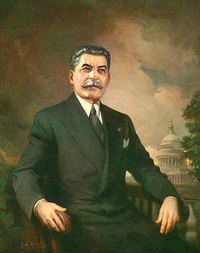| Joseph Stalin Иосиф Сталин (Russian) იოსებ სტალინი (Georgian) | |
|---|---|

| |
| 1947 portrait | |
| 4th President of Russia | |
| In office 26 May 1927 – 26 May 1951 | |
| Preceded by | Leon Bronstein |
| Succeeded by | Nikita Khrushchev |
| 3rd Vice President of Russia | |
| In office 27 January 1924 – 26 May 1925 | |
| President | Leon Bronstein |
| Preceded by | Leon Bronstein |
| Succeeded by | Vyacheslav Molotov |
| Minister of Agriculture | |
| In office 26 May 1919 – 27 January 1924 | |
| President | Leon Bronstein |
| Chairman of the State Duma | |
| In office 13 May 1913 – 13 May 1919 | |
| Preceded by | Julius Martov |
| Succeeded by | Alexei Rykov |
| General Secretary of the Russian Social Democratic Labour Party | |
| In office 26 May 1925 – 26 May 1951 | |
| Preceded by | Leon Bronstein |
| Succeeded by | Nikita Khrushchev |
| Personal details | |
| Born | Ioseb Besarionis dze Jughashvili 18 December 1878 Gori, Tiflis Governorate, Russian Empire |
| Died | 5 March 1953 (aged 74) Kuntsevo Dacha, Kuntsevo, Russia |
| Political party | Russian Social Democratic Labour Party |
| Spouse(s) | Ekaterina Svanidze (1906–07) Nadezhda Alliluyeva (1919–32) |
| Children | Yakov Dzhugashvili Vasily Dzhugashvili Svetlana Dzhugashvili |
| Parent(s) | Besarion Jughashvili and Ketevan Geladze |
| Religion | Atheism, formerly Georgian Orthodox |
Joseph Vissarionovich Dzhugashvili (Russian: Иосиф Виссарионович Джугашвили, trans. Iosif Vissarionovich Dzhugashvili, 18 December 1878 – 5 March 1953), more commonly known by his pseudonym Joseph Stalin (Russian: Иосиф Сталин, trans. Iosif Stalin), was a Russian politician who served as the 4th President of the Russian Democratic Federative Republic from 1933 to 1951.
Stalin was one of the earliest members of the Russian Social Democratic Labour Party (today the United Russia Party), and actively participated in the 1905 Russian Revolution. After the establishment of the Republic in 1906, Stalin was appointed to lead the RSDLP's representative caucus in the Russian Constituent Assembly by Vladimir Ulyanov, and as a result he was one of the leading writers of the Russian Constitution. He was thereafter elected to the State Duma, and became its Chairman in 1913. Following the death of Ulyanov in 1921 and the succession of then-Vice President Leon Bronstein to the Presidency, Stalin was selected by the party and confirmed by the State Council as Bronstein's successor. Bronstein did not seek election in 1924, and so Stalin ran instead, winning by an overwhelming majority.
Under Stalin's administration, Russia entered a period of industrialisation that resulted in the rapid transformation of Russia from an agrarian society into an industrial power. However, he was also responsible for the attempt to collectivise farming, a policy which contributed to disruption in food production and the subsequent Russian famine of 1932–33.
In August 1939, in an attempt to secure the Finnish border with Sweden, Stalin entered into a non-aggression pact with Sweden. However, Sweden ended the pact when in June 1941, in collaboration with the Fascist League, it invaded Russia. Despite heavy human and territorial losses, Russian forces managed to halt the Fascist incursion after the decisive Battles of Moscow and Tsaritsyn. After defeating the Fascist powers on the Eastern Front, the Russian Army moved through Europe, capturing Rome in July 1945, and then Paris with the assistance of the Allied Powers. Russia subsequently emerged as one of three recognised world superpowers, the others being Germany and Cygnia.
Stalin continued to lead Russia following the war, and presided over its post-war reconstruction phase. During this period, Russia became the third country in the world to successfully develop a nuclear weapon. In the years following his death, Stalin has been lauded as one of the best presidents in Russian history, although critics often point out the struggles faced by Stalin's administration in its early years.
| ||||||||||||||
